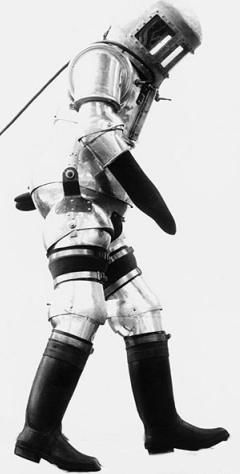
Home - Search - Browse - Alphabetic Index: 0- 1- 2- 3- 4- 5- 6- 7- 8- 9
A- B- C- D- E- F- G- H- I- J- K- L- M- N- O- P- Q- R- S- T- U- V- W- X- Y- Z
Schroeder, Rudolf Magnus
 German Pressure Sut |
The internet story is that famed Nazi commando Otto Skorzeny started training of an astronaut corps for the Third Reich in February 1944. 42, or 100, or even 500 pilots were said to be trained for this duty. Of these, six were selected for the honor of flying the A9/A10 manned ICBM against targets in New York in January 1945. On the first such flight the pilot was named as 'Rudolf Magnus Schroeder'. He rocketed into space from Peenemuende on 24 January 1945 in the presence of von Braun, Oberth, and other luminaries. Ten seconds into the flight, fire engulfed the cabin. Schroeder bit through his cyanide capsule to avoid a painful death. The rocket itself continued successfully, but without the guidance of the pilot, crashed in the North Atlantic.
In reality there was a manned A9/A10 project, and under Project Zement a production / launch facility for it was hollowed out of the rock at Ebensee, Austria. But in 1943 all work was stopped so that von Braun and his team could devote themselves completely to getting the V-2 into production. In October 1944, with V-2 launching units being pushed back by Allied advances out of range of England, SS General Kammler ordered von Braun to revive the A9 on a crash basis. But this was to extend the range of unmanned V-2 rockets, not to launch pilots into space. Von Braun managed to launch two prototypes, dubbed A4b, at the end of December 1944 and, yes, on 24 January 1945. But these were winged unmanned V-2 conversions, not manned space bombers. As the Allies entered German territory, the supply chain to Peenemuende collapsed, and no further tests of the A4b were possible.
Furthermore, there is no evidence that development of the A10 first stage and its enormous rocket motor ever got beyond paper calculations. The Peendemuende rocket team had enough trouble getting the V-2 motor into production. They had to mass produce a complex multi-chamber prototype instead of the planned simpler single-chamber version. The idea that they couldn't get the much smaller V-2 motor perfected but could manage the A10 just doesn't hold up. The Zement facility itself was used to house an oil refinery and for production of motor vehicle parts.
The training cadre part of the legend can be traced back to the effort to field a manned version of the V-1 subsonic cruise missile (not the V-2 ballistic missile). This indeed existed. The mission profile required the pilot to bail out on the final dive to the target, which was nearly suicidal. A training group was formed in the summer of 1944. Test flights were made, but in October 1944 it was decided that kamikaze missions were not a part of the German military tradition. The unit was disbanded without having flown in combat.
Family: Cosmonaut. Country: Germany. Bibliography: 13400.
Back to top of page
Home - Search - Browse - Alphabetic Index: 0- 1- 2- 3- 4- 5- 6- 7- 8- 9
A- B- C- D- E- F- G- H- I- J- K- L- M- N- O- P- Q- R- S- T- U- V- W- X- Y- Z
© 1997-2019 Mark Wade - Contact
© / Conditions for Use